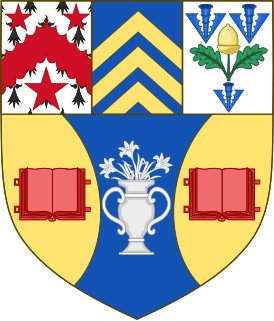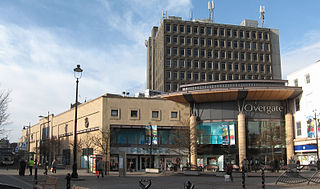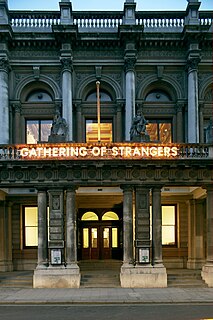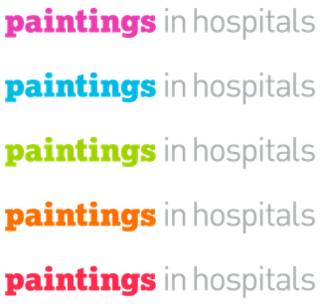
Dundee is Scotland's fourth-largest city and the 51st-most-populous built-up area in the United Kingdom. The mid-year population estimate for 2016 was 148,210, giving Dundee a population density of 2,478/km2 or 6,420/sq mi, the second-highest in Scotland. It lies within the eastern central Lowlands on the north bank of the Firth of Tay, which feeds into the North Sea. Under the name of Dundee City, it forms one of the 32 council areas used for local government in Scotland.

Arts Council England is an arm's length non-departmental public body of the Department for Digital, Culture, Media and Sport. It is also a registered charity. It was formed in 1994 when the Arts Council of Great Britain was divided into three separate bodies for England, Scotland and Wales. The arts funding system in England underwent considerable reorganisation in 2002 when all of the regional arts boards were subsumed into Arts Council England and became regional offices of the national organisation.

Abertay University, formerly the University of Abertay Dundee, is a public university in the city of Dundee, Scotland. In 1872, Sir David Baxter, 1st Baronet of Kilmaron, left a bequest for the establishment of a mechanics' institute in Dundee and the Dundee Institute of Technology was formed in 1888. As early as 1902 it was recognised by the Scottish Education Department as an educational hub, and was one of the first to be designated a central institution, akin to an "industrial university". Abertay gained University status in 1994.

The Overgate Centre is a shopping centre in Dundee, Scotland. Built in the 1960s to replace buildings erected in the 18th and 19th centuries, most of the original structure was demolished and redeveloped from 1998 to 2000.

Hew Martin Lorimer, OBE was a Scottish sculptor.

Dundee Contemporary Arts (DCA) is an art centre in Dundee, Scotland, with two contemporary art galleries, a two-screen cinema, a print studio, a learning and public engagement programme, a shop and a café bar.

Art on the Underground, previously called Platform for Art, is Transport for London's (TfL) contemporary public art programme. It commissions permanent and temporary artworks for London Underground, as well as commissioning artists to create covers for the Tube map, one of the largest public art commissions in the UK.
Until the industrial revolution, the current City Centre represented the full extent of the City of Dundee, Scotland. Now roughly encircled by the market gait dual carriageway, the city centre is now the main shopping and commercial district. Unlike the city centre of Glasgow, many of the city centre's streets are not built on a grid plan and in that way have more in common with the street plan of the Old Town of Edinburgh.

Nathan Coley is a contemporary British artist who was shortlisted for the Turner Prize in 2007 and has held both solo and group exhibitions internationally, as well as his work being owned by both private and public collections worldwide. He studied Fine Art at Glasgow School of Art between 1985 and 1989 with the artists Christine Borland, Ross Sinclair and Douglas Gordon amongst others.

The Royal Arch or Victoria Arch was a structure erected in Dundee, Scotland, between 1849 and 1853 and demolished in 1964. The monumental archway formerly stood over the access to the pier between Earl Grey Dock and King William IV Dock on the city's waterfront.
The Edinburgh Art Festival is an annual visual arts festival, held in Edinburgh, Scotland, during August and coincides with the Edinburgh International and Fringe festivals. The Art Festival was established in 2004, and receives public funding from Creative Scotland. In 2022, Kim McAleese was appointed Festival Director, succeeding Sorcha Carey. Carey is now Director at Collective, Edinburgh.

Mike Stubbs is a curator/director and filmmaker based in the UK, currently, the Creative Producer at Doncaster Creates. For 11 years he was the Director/CEO of FACT, the Foundation for Art and Creative Technology, a leading arts organisation for the commissioning and presentation of new media art forms. He has been a key contributor to the development of culture and cultural policy in Liverpool, UK. Stubbs was jointly appointed in May 2007 by Liverpool John Moores University, where he is Professor of Art, Media and Curating. He is father to two daughters Saskia and Lola Czarnecki-stubbs.
Shape Arts or Shape is a London-based arts charity, working across the UK and internationally. funded by Arts Council England, that provides opportunities for disabled individuals wanting to work in the arts and cultural sector. It trains participants and runs arts and development programmes across all of the creative arts: visual arts, music, dance, writing and acting.
Sylvia Grace Borda is a Canadian artist working in photography, video and emergent technologies. Borda has worked as a curator, a lecturer, a multimedia framework architect with a specialization in content arrangement (GUI) and production. Born and raised in Vancouver, Borda is currently based in Vancouver, Helsinki, and Scotland. Her work has been exhibited locally, nationally, and internationally.

Professor Ross Sinclair is a Scottish visual artist, musician and writer. He lives and works in Kilcreggan, Argyll and is currently Reader in Contemporary Art Practice at The Glasgow School of Art, whilst also maintaining his professional practice. Sinclair was one of the key figures in the movement of contemporary artists in Glasgow in the 1990s, dubbed the 'Glasgow Miracle' by art curator and critic Hans-Ulrich Obrist.

Paintings in Hospitals is an arts in health charity in the United Kingdom. Founded in 1959, the charity's services include the provision of artwork loans, art projects and art workshops to health and social care organisations. The charity's activities are based on clinical evidence demonstrating health and wellbeing benefits of the arts to patients and care staff.

The City Art Centre is part of the Museums & Galleries Edinburgh, which sits under the Culture directorate of the City of Edinburgh Council. The City Art Centre has a collection which include historic and modern Scottish painting and photography, as well as contemporary art and craft. It is an exhibition based venue with no permanent displays.

The Usher Gallery is an art museum in Lincoln, England. The gallery displays a collection of artworks by painters such as J. M. W. Turner and L. S. Lowry. Established in 1927, it is run as part of the Collection.
Fanny Lam Christie is a Hong Kong-born artist who specializes in sculpture and works in Scotland. She currently works from her studio in Perthshire, Scotland.
Elizabeth Ogilvie is a Scottish environmental artist renowned for her work exploring the impact of climate change. Her work is held in several public and private collections and she exhibits internationally. Ogilvie is considered one of the most significant Scottish artists of her generation.













